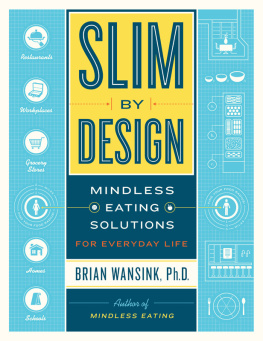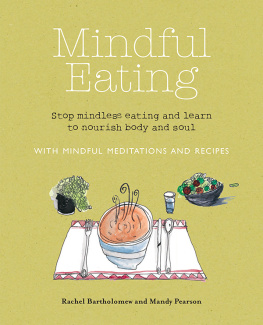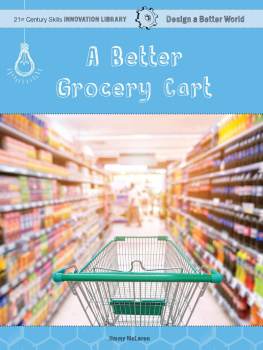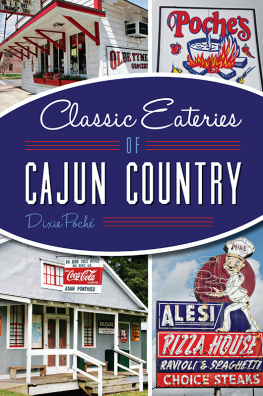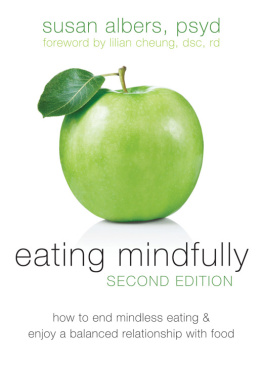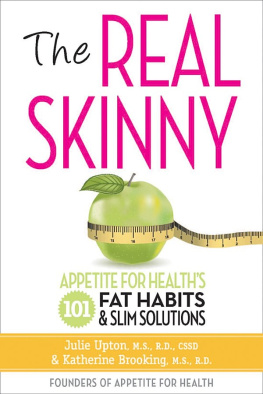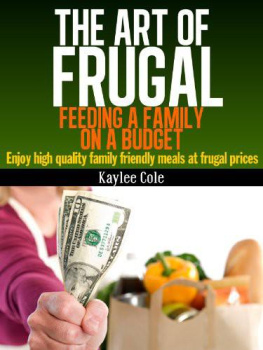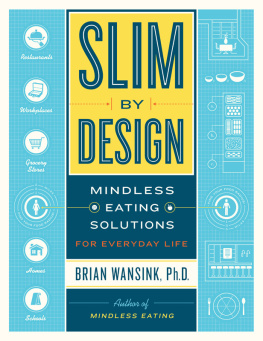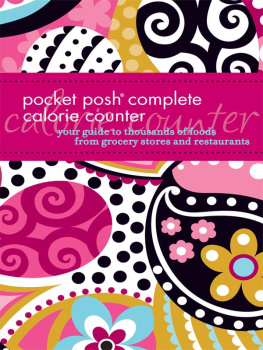To my passionate, restless, tireless past, current, and future coauthors, colleagues, and students. To the trusting sponsors and donors who have believed in this mission since 1987. And to bold, insightful, and generous academic journal editors and reviewers who have made our work stronger and more relevant by caringly pushing it to the next level of rigor and impact.
CONTENTS

T HIS BOOK IS BASED ON a very basic concept: Becoming slim by design works better than trying to become slim by willpower. Its easier to change your eating environment than to change your mind. Slim by Design is about changing your eating environmentwhat I call your food radiusso that you, your kids, and even your neighbors eat less and eat better. These are simple actions you can take to become permanently slimmer without really working at it. And you can get others to help.
NABISCO HEADQUARTERS, SPRING 1996. Two dozen Nabisco executives are staring at me with their mouths frozen openlike I was Medusa with snakes for hair or like I had just finished yodeling. Instead, I had just told them that if they sold mini-packs of their snacks, theyd make more money and help make people skinnier. Sell less foodmake more money. Just like in a cartoon, I could see a big collective thought bubble above their heads: SELL LESS AND MAKE MORE?
Why was I so sure of my theory? Because I had made a mistake. But one of those good kinds of mistakes that lead to a nice surprise, and not one of those bad kinds that lead to a viral YouTube video with Epic Failure in the title.
For two years, my graduate students and I had been tweaking food package sizes and shapes to see how they changed how much food people ate, how much they liked it, and how much they threw away. Although we were originally interested in sustainable packaging that reduced waste, we just kept seeing the same thing over and over. The bigger the package, the more people ate and the more they liked it. This was true for everyone we tested, and its probably true for everyone from competitive hot dog eaters in Coney Island to desperate housewives in Beverly Hills.
Then came the Philadelphia Experiment. We were giving Philadelphia moviegoers free foodWheat Thins and M&Msto see if they realized how much more they were eating from big packages. We would take 440 calories worth of snacks and repack them in large clear zipper bags to make sure they could see all they ate and all they didnt. Unfortunately, we ran out of these big bags and had to give some moviegoers four tiny, Tinkerbell-size bags I had mistakenly bought. These each held about 110 caloriesabout the same amount of M&Ms that are in those fun-size packs that some of us give disappointed trick-or-treaters on Halloween.
Our moviegoers watched the movie and munched away. Afterward, we collected and weighed their bags. What confused us was that moviegoers with the four Tinkerbell-size bags ate about half as much as those with the full 440-calorie one. When they got to the end of their first or second 110-calorie pack, they just stopped eating. Pay more to eat less? This should be a snack companys dream come true.
At that time, I was a consumer behavior professor at the University of Pennsylvanias Wharton School, in Philadelphia. Since Philly is only four hours away from companies like M&M/Mars and Nabisco, I called them up and said, Hey, I found a way you could make more money by helping your customers eat less! Within a week, I had scheduled presentations at these companies and was hopping into my Jeep Cherokee to spread the good news, feeling like the Johnny Appleseed of mini-size packs.

Sell less and make more?
About thirty executives came to each of my presentations, and the first half hour would go pretty well. Id show them how all the people in our studies ate more from bigger packages, and theyd nod and write down the numbers. But the train wreck always happened at the climactic ta-da moment when I revealed my conclusion: If they sold mini-size packs, people would pay more and eat less. The same thing always happenedthey just froze and stared at me with confused frowns. If we sell smaller snack packages, people would pay more... and eat less? I dont understand. Every drive home was a buzz-kill disappointment.
But five months later, one of the less skeptical execs who had moved from M&M/Mars to Nabisco called and said, Do you really think we can make more money by selling mini-size packages? I drove back to their headquarters and described this and other studies in more detail. Eventually Nabisco/Kraft gave my theory a try and launched the 100-calorie pack. Within two years they were followed by the other companies Id visited, including M&M/Mars, Kelloggs, and others. These mini-size packs helped about 70 percent of all tummy-conscious snack lovers to mindlessly eat less, without having to count out their potato chips.
WERE ALL MINDLESS EATERS. Each of us makes more than two hundred nearly subconscious food choices every daysoup or salad? A little or a lot? Finish it or leave it? But most of these subtle nudgesthe size of our cereal bowl, the distance of the candy dish, the color of our platespush us to eat too much.
Even though I was appointed by the White House to be executive director of the U.S. Department of Agricultures agency in charge of the 2010 United States Dietary Guidelines, and even though I am a past president of the Society for Nutrition Education and Behavior, I still dont think most nutrition education is very effective. People know that an apple is better for them than a Snickers bar, but... they eat the Snickers bar anyway.
Of course, its good to understand nutrition, but its much more effective to change our eating environment. Once youve made the right changes to your eating environment, youll start eating better without thinking about it. You can make healthy decisions even when your brains on autopilot.

You dont need any magical skills to make these changes.
This will be hard for you to believe at first. It was just as hard for the Nabisco execs to believe that the 100-calorie pack would succeed as well as it did. I know these small changes can work because my Lab has spent the past quarter century proving this repeatedly in scientific study after study.

The easiest, quickest, and most natural way to slim down ourselves, our families, our neighborhoods, and our country is to work with human nature and not against it. Willpower alone wont conquer bad eating habits for 90 percent of us. Fortunately, there are a lot of small, innovative, and proven solutions from behavioral economics and psychology that will help make us become slim by design

